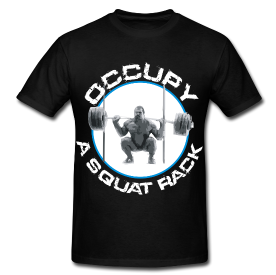Happy PR Friday, great day to be alive. Now it’s business time.
And in case you missed it, here’s one of the new shirts (also available for women):
Adam W. asks on the Facebook fan page:
Justin, if you can figure out why I got 3 whites on this lift…
…and 3 reds on this one.
I will be very grateful. And since my deadlift lockout is the ugliest thing in lifting history, I was wondering if you think rack pulls might be a good way to clean them up, and if so how do you usually program them?
Dear Adam,
We talked back and forth about this on the page, but I thought it was good topic for everyone else to see. The federation is the CPF which is a WPC affiliate. Personally I’ve only coached in the USAPL, which is under IPF ruling.
Adam is a glaring example of blatantly removing tension from the hamstrings during the deadlift lockout. I don’t think the last attempt in the second video should have been red lighted, but the excessive forward knee movement emulates what would happen when the bar is hitched. Had the bar stopped moving, I would agree with them, yet it continued to move. Your feet remained in the same place, you locked your knees out at the top, and lifted the chest at the top. That jacked loader on the right was surprised it was red-lighted too. Whatever the problem was, it was something that all three judges agreed on. They must have considered your shitty knee position a hitch, I guess. My suggestion would be to go over the rule book and find out what happened.
However, the fact that you remove hamstring tension is something that you can (and need to) control. Adam told me he’s doing RDLs, but I’d still want to see how he’s doing them because I have a hunch he’s flexing his knees too much and not getting the full use of them. In any case, he asked about rack pulls. Rack pulls will definitely help this pulling issue when they are done correctly. The bar should be put right below the knee (at about the tibial tuberosity), and the lower back should remain locked in place during the movement. You don’t need to hyper-extend it (I’ve been hurt this way), but the goal is to not allow it to flex. If it flexes, then it slackens the hamstring tension. Do not allow your knees to shift forward under the bar (like you’re currently doing in your deadlift). By doing it this way, you won’t be able to use as much weight as you think you can, and it will probably be lower than what you deadlift. This is fine. Chris’ set of five on rack pulls is still below what his max is.
Lastly, when you do actually deadlift, think about keeping the knees back (cue is “knees back”). Really work on this since a) knees forward is causing you to miss lifts in meets and b) strengthening your hamstrings by maintaining tension during deadlifting and rack pulling will make for a stronger deadlift. If you’re confused, see Chris’ 650 miss on his third attempt at USAPL Raw Nationals in 2010 compared to his last three meets: 661, 666, and 677.
Continue reading

